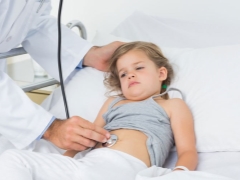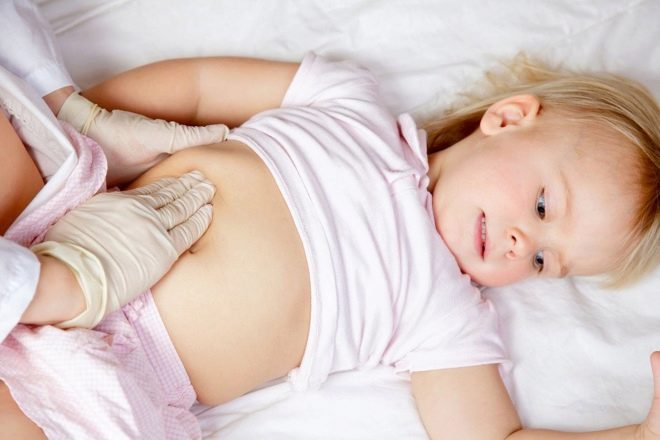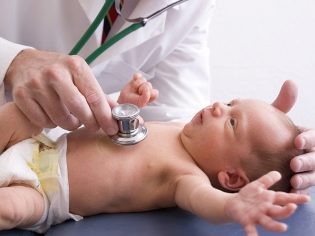What should I do if my child’s liver is enlarged?
Everyone understands that without a normal healthy liver, a person cannot fully exist. That is why parents have many questions about the increased size of this organ in children. What to do if a child has an enlarged liver, you will learn from this article.
The size of the liver - the norm
The size of the liver is usually determined by three parameters: to the right along the periphery line, to the left along the oblique line and along the midline of the breast. How pass the lines can be seen in the picture. The normal size of the liver in a healthy child is:
- Up to 3 years - 5 cm to the right along the okolososkovoy line, 4 centimeters along the median line, and no more than 3 centimeters along the left oblique line.
- Up to 7 years - on the right along the isle line - no more than 6 centimeters, on the midline sternal line - 5 centimeters, on the left oblique - no more than 4 centimeters.
- Up to 12 years old - to the right along the isle line - no more than 8 centimeters, along the median line - 7 centimeters, along the left oblique - 6 centimeters.
- Over 12 years old - to the right along the isle line - 10 centimeters, along the median line - 9 centimeters, along the oblique left line - 8 centimeters.
In a normal healthy child, the liver should not be enlarged. Also, it should not go beyond the costal arch.
The exceptions are newborns and children who have not yet turned 1 year old. They have such a way out of the costal arch can be quite normal physiological phenomenon, if the output does not exceed 2 centimeters.
In children 5-6 years of age, the liver may also go beyond the costal arch, however, it should not normally exceed 1 centimeter. Any deviations from the above standards are considered to be an increase in the liver and may indicate possible pathologies.
What do deviations say?
An enlarged liver is not an independent disease, but a symptom of a disease. The symptom in medicine is called hepatomegaly. Not every increase should be considered an alarming symptom. If the child is not yet seven years old, if his size is increased slightly, doctors do not consider such a condition to require medical intervention.
If the size of the liver is enlarged significantly or hepatomegaly is first identified after the age of seven, this symptom will be regarded as pathological, and all the efforts of the doctor will be directed to finding the true cause of liver enlargement.
A vital organ can "grow" in size due to congenital abnormalities:
- intrauterine infections;
- viral diseases that affected the fetus during pregnancy (primarily rubella, toxoplasmosis, and cytomegalovirus);
- congenital absence or fusion of the bile ducts (arthrezia);
- diseases of the cardiovascular system, during which this or that degree of heart failure develops;
- hemolytic disease, which occurred with the fetus during pregnancy due to Rh-conflict with the mother, as well as a disease that “started” after the birth of the child into the world for the same reason (usually happens to Rh-positive babies born to Rh-negative mothers );
- numerous cysts;
- hereditary diseases of blood circulation and blood vessels, in which the vessels expand pathologically, which is accompanied by spontaneous bleeding.
The liver may increase for other reasons that are not innate:
- Infectious mononucleosis;
- viral hepatitis;
- strong toxic poisoning poisons or chemicals;
- inflammation of the gallbladder;
- tuberculosis;
- syphilis;
- obesity and metabolic diseases;
- diabetes;
- oncological diseases and blood diseases (lymphoma, leukemia, etc.).
To increase the size of the liver can lead violations of the principle of balanced baby food, especially if carbohydrates and fats prevail in the baby’s diet, and proteins are not enough. If the pathology has congenital causes, then it is usually possible to establish it even in the first year of a baby’s life, because the pediatrician will not be able to notice during an examination that the liver is larger than the palpation. Pathological changes of acquired character are usually diagnosed later, closer to 5-7 years.
Since the list of possible causes is extremely wide, it is better not to try to figure out the true one yourself.
Hepatomegaly is a syndrome that cannot be ignored.After all, not only the health of the crumbs in the future, but also their life depends on how quickly and correctly the child will be provided with qualified assistance.
Signs of pathologies
It is clear that parents can not independently measure the baby’s liver in order to understand whether it has abnormalities. But to suspect that something is wrong, any mom can on a number of signs that may indirectly indicate liver problems:
- the child often complains of heaviness in the abdomen, while the upper abdomen on the right is somewhat painful when lightly pressed by hand;
- skin has a yellow or yellowish tint, yellow eyeballs;
- the baby has nutritional problems - lack of appetite, nausea and vomiting, stool instability, frequent diarrhea;
- fecal masses become very light, sometimes almost white, and urine, on the contrary, darkens;
- prolonged jaundice of newborns (if more than two weeks have passed after discharge from the hospital, and the child still remains yellow, this is a reason to check the liver);
- characteristic bitter smell from the mouth (not mandatory feature!).
Where to go?
If the parents suspected liver problems in the child, you should definitely visit the pediatrician with the child. Of course, such a specialist, as a hepatologist, will be able to sort out the problem much faster, but there are not so many doctors of such rare and narrow specialization in Russia, and they are far from accepting in every clinic.
If there is an opportunity to visit such a doctor, it is better to do it. If there is no hepatologist, a pediatrician and a gastroenterologist will help. In such a duet, two specialists will surely find pathological causes, if any, and be able to prescribe adequate treatment. Tightening with the beginning of the survey is strictly prohibited. Any malfunction in the liver, and an increase is also considered a malfunction, increasing the likely intoxication. After all, the natural, created nature of the "filter" of the body - the liver - does not work fully.
Usually, to establish whether the child has a liver and spleen enlarged, an experienced pediatrician can already with the help of his hands - palpating and tapping the liver area. Suspicion confirms ultrasound diagnosis.
On ultrasound, you can see not only the exact size of the liver (up to millimeters), but also possible changes in its tissues, violations in the right or left lobe.
If the diagnostician indicates an increase, then the pediatrician will prescribe a child a complete blood count, urinalysis, feces analysis of parasite eggs and bile, biochemical laboratory blood tests, computed tomography, less often MRI. If tumors and neoplasms are found, the child is hospitalized in order to take biopsy samples of liver tissue under anesthesia using a laparoscope.
Treatment
Children up to 7-8 years old, a small enlargement of the liver (a little more than 2 centimeters) is corrected with the help of medications. Surgical intervention is permissible only in the case of gross and severe liver lesions of congenital nature associated with structural anomalies. Treatment always begins with the treatment of the main disease identified.If a viral infection is to blame, the child may be hospitalized and undergo inpatient treatment with a course of effective antiviral drugs («Tamiflu»). At home, such drugs are not prescribed, and all available antiviral drugs from the pharmacy ("Anaferon" and others) are not officially considered effective and affecting the course of a viral infection.
Bacterial infections or diseases with attached inflammatory processes are usually treated with antibiotics, choosing the least severe ones so as not to exert additional drug "pressure" on the liver. Metabolic diseases are treated by an endocrinologist with the use of special drugs that improve and normalize metabolic processes. Simultaneously with the treatment of the underlying disease, a special hepatoprotective therapy is prescribed to a child with an enlarged liver. It includes funds whose task is to support the already suffering liver during the drug load.
Usually in the maintenance therapy for the liver there are such drugs as Essentiale, «No-shpa», "Karsil", "Heptral" and «Duspatalin». Among the hepatoprotectors most commonly prescribed in childhood, it can be noted Galsten, «Ursosan», "Cholenim".
In order for the child's body to work better, in the course of treatment, preparations are prescribed that contain important enzymes, which due to pathology can be produced in insufficient quantities. These drugs include «Creon», "Mezim".
For too long, taking enzymes is not worth it, so as not to "spoil" the child's body. Otherwise, it will reduce the production of its own enzymes to naught, which then will lead to very disastrous consequences.
A child, regardless of the cause that led to a hepatic increase, assigned a special diet. From the menu of the child completely for a long time remove fatty foods - butter, lard, cheeses with a high percentage of fat, full-fat milk and sour cream. Cocoa, chocolate, eggs, mushrooms, nuts, fatty meats, sour drinks, including fruit juices, canned and smoked meats, spices and even ice cream are strictly forbidden to a kid with hepatomegaly. Adherence to the diet is very important, otherwise the treatment may be ineffective, despite taking the prescribed drugs. The child needs lean meats, vegetables, food, steamed and baked. Fried and fresh pastries should be avoided. You need to eat fractional, at least 5 times a day in small portions.
No doctor will give predictions in the treatment of enlarged liver in advance, because a lot affects the outcome of the pathology - the main disease, the immune status of the baby, and the degree of increase in the liver itself. However, timely treatment and promptly initiated treatment, according to statistics from the Ministry of Health in 2016, provide a favorable prognosis in more than 90% of cases.
It is most difficult to predict an increase in liver oil if it is caused by toxic poisoning, as well as by complicated onset of cirrhosis. Such problems are much worse than therapy, but even here a positive outcome is estimated at more than 60%.
Prevention Tips
To protect your child from liver problems, mother can still at the stage of pregnancy. If she attentively treats her health, protects herself from infections, viruses, then the chances of pathological changes in the setting and functioning of the digestive organs in the body of the crumb will be minimal.
A child of 2 years old, like a child of 3-4 years old and older, should not have on the table an abundance of fatty and carbohydrate foods, especially with a sedentary lifestyle. The obsession with fast food at an older age - at 8-10 years old - can also lead to liver obesity, and this will be quite dangerous, since such an increase will never be considered physiological. One advice - you need to be attentive to the nutrition of the child.
Prevention also includes the precautions that parents should take when storing toxic substances at home for their homes. Free access may cause severe poisoning in the child with irreversible changes in the liver.
Quite often, on the advice of friends and relatives, parents take it themselves and give children "to clean the liver" certain decoctions, tablets and powders. Now a big and profitable business is built on such pseudo-drugs. No decoctions and pills should be given to the child for the prevention of liver problems.! If there are problems - you need to go to the doctor. If not - enough healthy food, active leisure, sports, nothing to “clean up” is needed.
All about the size of the liver, see the following training video.



























